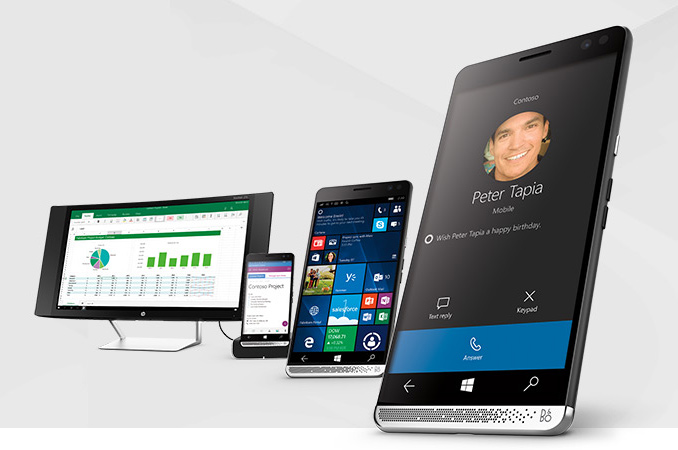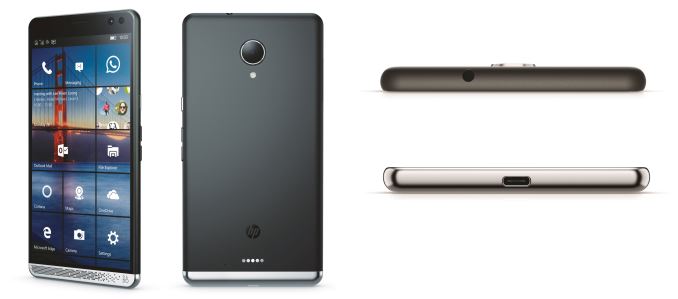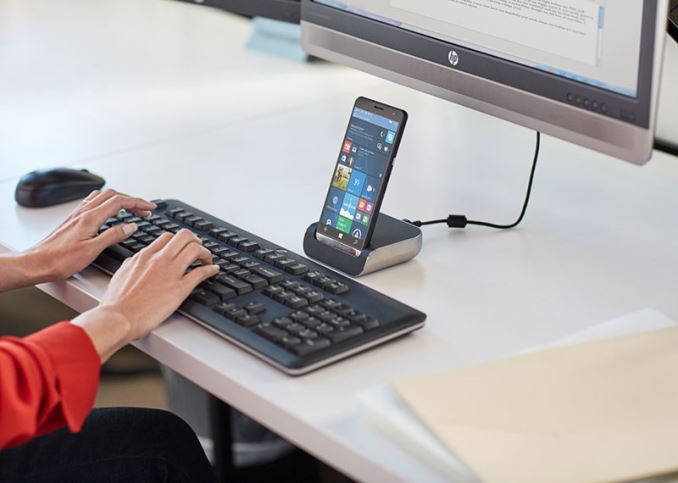HP’s Elite x3 Windows 10 Smartphone to Cost $699, Set to Be Available Worldwide
by Anton Shilov on July 21, 2016 11:00 AM EST- Posted in
- Smartphones
- HP
- Microsoft
- Windows 10 Mobile
- Continuum

When HP introduced its flagship Elite x3 phablet earlier this year at MWC, the smartphone made a very positive impression mostly because HP decided to make a bold move and create a Windows Continuum device aimed purely at the business professional on a company contract. It drew a little ire from some industry analysts, thinking that HP building a Windows phone would never see the light of day. To them it was a paper announcement, but this week shows that the Elite x3 is still alive and well, and coming to consumers and business users. What the company did not announce in February was its recommended price as well as countries, where it planned to make the product available. This weeks details show that the Elite x3 will hit the market in August and will be sold in 46 countries worldwide.
The HP Elite x3 smartphone is based on Qualcomm’s Snapdragon 820 SoC, as well as Microsoft’s Windows 10 Mobile OS. The device is equipped a 5.96” AMOLED display and comes with 64 MB of eMMC 5.1 NAND flash storage, 4 GB of LPDDR4 RAM as well as all the necessary connectivity features, including 4G/LTE, 802.11ac Wi-Fi, Bluetooth 4.0 and a USB Type-C connector. Developed specifically for enterprise and business users, who value security, the device is FIPS 140-2 certified and features Secure Boot (with iris and fingerprint scanners), full disk encryption with a 256-bit key, fTPM 2.0, and so on.
| HP Elite x3 | |
| SoC | Qualcomm Snapdragon 820 2x Kryo @ 2.15 GHz 2x Kryo @ 1.59 GHz Adreno 530 |
| RAM/NAND | 4 GB LPDDR4 RAM, 64 GB eMMC 5.1 NAND microSD 'up to 2 TB' |
| Display | 5.96-inch, 2560x1440 AMOLED (494 PPI) Corning Gorilla Glass 4 |
| Network | X12 Cat 12/13 LTE-A Single Nano-SIM or Dual Nano-SIM Models Micro-SD Shared with Nano-SIM |
| Dimensions | 161.8 x 83.5 x 7.8 (mm) 6.36 x 3.29 x 0.31 (in) |
| Weight | 195 grams 0.43 lb / 6.88 oz |
| Rear Camera | 16 MP, LED Flash |
| Front Camera | 8 MP wide angle, Iris Camera |
| Battery | 4150 mAh, 3.85 V, 15.98 Wh, PMA and Qi charging |
| OS | Windows 10 Mobile |
| Connectivity | Intel AC-7260AN WiFi (2x2 802.11ac + BT 4.0 LE) NFC, GPS USB 3.0 Type-C |
| Additional | Windows Hello (Iris and Fingerprint), FIPS 140-2, fTPM 2.0 128-bit Unified encryption, 256-bit full disk Disaster recovery Protection Win10 includes 128-bit BitLocker and Enterprise Grade VPN Bang&Olufsen Sound 3x Noise-Cancelling Microphones |
| Water/Dust Proof Certification | IP 67 MIL-STD 810G (salt/fog/humidity/shock/thermal) |
While the internal specifications of the HP Elite x3 are impressive, the company does not position the device as just its flagship smartphone. HP believes that there are enterprise customers interested in using one device for multiple workloads and in various situations by taking advantage of Microsoft’s Continuum technology, which allows you to run your phone as a desktop PC. To support such clients, HP intends to offer a special dock (with an Ethernet adapter, DisplayPort USB connectors, etc.) that can work with desktop displays as well as keyboards. When purchased from the HP online store, the dock should come as standard. In addition, the company plans to sell the Mobile Extender laptop, which does not have its own processor or storage, but relies on the Elite x3. The Mobile Extender has a 12.5” display (with 1920x1080 resolution), USB-C ports, speakers as well as a spill-resistant keyboard with a drain and backlighting.
Current competition, at least in the Continuum space, comes from Acer's Liquid Jade Primo which was demoed at MWC and quietly shipped several days ago, and the Lumia 950.
According to Engadget, which cites a representative of HP, the phablet itself will cost $699 in the U.S. and $799 when acquired with a dock, starting from August 29. Slashgear claims that the Elite x3 will cost €863 in the Netherlands and 8,624 SEK in Sweden. Unfortunately, the price of the Mobile Extender is still unknown.
Sources: Engadget, Slashgear, HP Netherlands, HP Sweden.














67 Comments
View All Comments
elitewolverine - Monday, July 25, 2016 - link
Yea no. I highly doubt you had a 1520, and if you were having those issues you had hardware not software issues. And most likely a bad cheap sd card that will kill your z3 over time. I have 2 1520's, I ran win 10 since day one in preview, I lived with many bugs. Yet it was always more stable than half our phones here in our carrier (yes I work at a carrier). Even now it is used as a day to day next to the 950xl. The battery lasts 16hrs+ on a normal day of usage I have even got 30+hrs out of it depending on my use. I cannot remember the last time it 'randomly' rebooted itself, but I can tell you the last time my s7 did here and the note edge and the s5 and the z3 and z1s and and and. At any moment I am within reach of over 15 devices, from the s7 all the way down to the grand prime, I leave everyday after dealing with android and iphone in a tech environment thanking fully that I use windows 10. The app gap is minimal and anything I truly need can be remoted into my desktop via vpn and bluestacks or vox or or or. Or take out my windows tablet and emulate, or if I really really really needed android (I don't), I can get me a cheap 70 buck 7in tablet with 4g/lte and call it a day.lazarpandar - Thursday, July 21, 2016 - link
Really cool stuff but I can't help but think that Continuum is just going to go the way of Windows RT.Microsoft's ace in the hole is a Windows 10 phone with an x86 processor that can do full windows while docked. With Thunderbolt 3 technologies and increasingly efficient CPUs from Intel I feel like this is a forgone conclusion.
Death666Angel - Thursday, July 21, 2016 - link
"CPUs from Intel I feel like this is a forgone conclusion."I thought Intel axed any smartphone SoC plans.
lazarpandar - Thursday, July 21, 2016 - link
Well I'm dumb.Morawka - Thursday, July 21, 2016 - link
no need for a smartphone only soc anymore. Core M is already pulling 5W, imagine 5 years from now on 10 and 8nm how many watts core m will pull. intel is spending a good bulk of it's R&D money on LTE Modem development this year.Spunjji - Friday, July 22, 2016 - link
After the disasters of Atom I would be surprised to see any major phone manufacturer willing to partner with them, especially when Apple and Samsung design their own ARM chips. Add to that how in 5 years time ARM designs will easily be able to compete with whatever Core part Intel might wish to throw at this market... it doesn't look great.ACE76 - Friday, July 29, 2016 - link
you obviously have no idea what you're talking about...ARM as fast as an Intel Core CPU? LOL...Intel would destroy any ARM CPU in the world regardless of who made it if they put a Core M CPU into a smartphone....and they're not that far off from being able to do it.Impulses - Thursday, July 21, 2016 - link
Yet Intel already bailed on mobile SoCs...osxandwindows - Thursday, July 21, 2016 - link
This has windows RT all over it.domboy - Thursday, July 21, 2016 - link
The idea is good, and I think business is where the Continuum feature makes the most sense. The problem is even when docked it won't be as useful as it should be since Microsoft locked down the ARM platform too much. If they would let a full desktop mode be enabled it would be more compelling, but it would have to get rid of the API restrictions or it'd just be another Windows RT. Alternately an x86 version of this phone would also work, and probably be even better since no re-compile (for ARM) would be required. Probably the biggest argument I'd expect against such an idea is battery life issues, but could be avoided by just shutting down any win32 apps when the phone gets pulled from the dock.